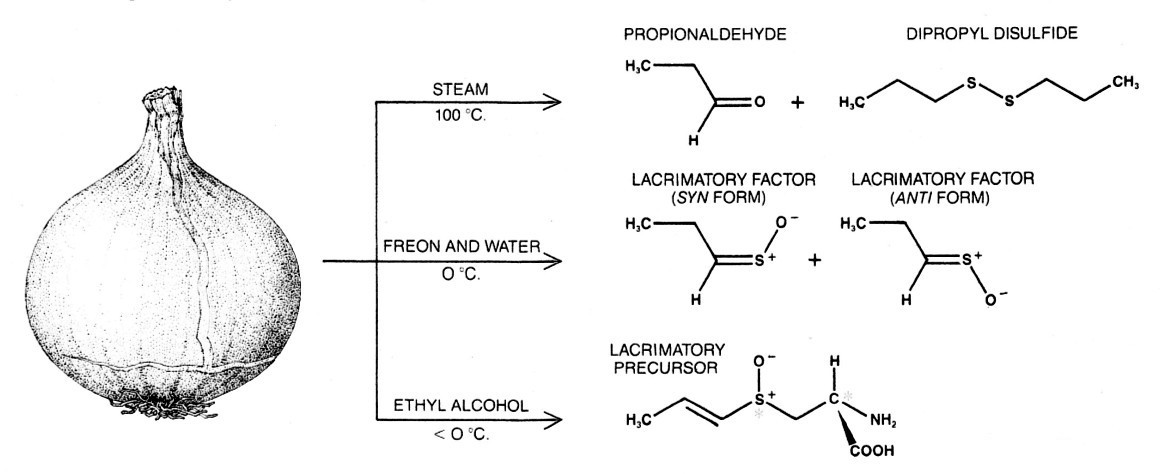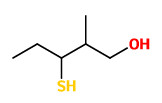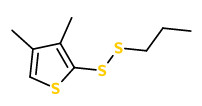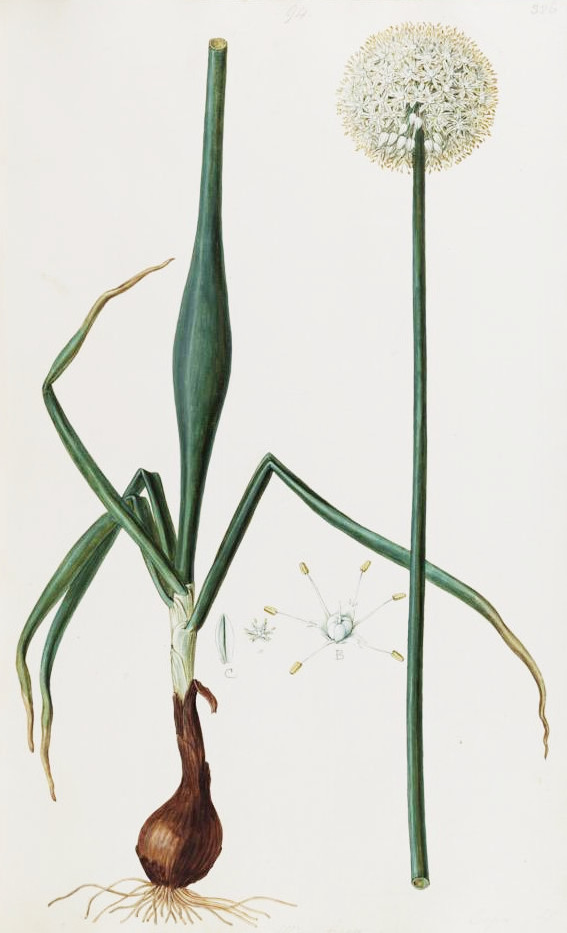Allium cepa L. - Liliaceae - (common) onion, Zwiebel, Küchenzwiebel
Biennial herb, up to 120cm tall, native probably to West Asia, only known in cultivation (nearly everywhere); various in habit, large in bloom; leaves hollow, tubular, radical and basal, swollen; stem swollen below middle; flowers white, many, in large umbel subtended by 2 or 3 reflexed bracts; bulbs often large.
„The onion of commerce, Allium cepa is widely cultivated as a biennial in North America, Europe, and Asia. It is unknown in the wild and is probably derived from A. oschanini of central Asia. The cultivated form is often polyploid (2n = 16, 32, 54) and possibly of hybrid origin. It exists in numerous cultivars, a few of which form large bulbils in the umbel.“
http://www.efloras.org/florataxon.aspx?flora_id=1&taxon_id=200027457
Allium cepa L. var.aggregatum G. Don = Allium cepa var.ascalonicum = Allium ascalonicum auct.: shallot, Schalotte (plant with aggregate cluster of several bulbs)
Allium cepa L. var.cepa = (bulb) onion, Spanish onion, spring onion, Küchenzwiebel, Frühlingszwiebel (plant with single bulb)
„In Allium cepa (cv. Creamgold), A. cepa (cv. Bunching Onion), A. porrum (leek) and A. sativum (garlic), fructans were the only nonstructural carbohydrates detected apart from glucose, fructose and sucrose. No starch or members of the raffinose series of oligosaccharides were detected. Both cultivars of A. cepa, and A. porrum had fructan polymers of the same length. “
[Differences in fructan content and synthesis in some Allium species., Darbyshire, B., Henry, R.J., New Phytologist, Vol.87(2), 1981, 249-256]
„… the synthesis of the fructooligosaccharide polymers is localized in the vacuoles of the cells. The FOS consist of polymers of fructose attached to sucrose molecules. In onion, as in liliaceous plants, special types
of FOS called the inulin neoseries are produced. In these types of FOS, the fructose residues are linked to 1-OH of fructofuranose residue and 6-OH glucopyranose residue.“
[The metabolism of the fructooligosaccharides in onion bulbs: A comprehensive review., Shiomi, N., Benkeblia, N., Onodera, S., J Appl Glycosci, 52(2), 2005, 121-127]
http://www.mona.uwi.edu/lifesciences/hortlab/papers/JAGS.2005.pdf
Mammals are unable to metabolize fructans, but the human colon has been estimated to harbor between 500 and 1,000 species, representing over 7,000 strains, several of them containing fructanases and can convert fructans to fructose. Products of fructan degradation include lactate, butyrate, CO2 and H2, leading to flatulence.
[In vitro kinetics of prebiotic inulin-type fructan fermentation by butyrate-producing colon bacteria: implementation of online gas chromatography for quantitative analysis of carbon dioxide and hydrogen gas production., Falony, G., Verschaeren, A., De Bruycker, F., De Preter, V., Verbeke, K., Leroy, F., De Vuyst, L., Applied and environmental microbiology, Vol.75(18), 2009, 5884-5892]
http://aem.asm.org/content/75/18/5884.full
„Sulfur compounds extracted from onions also depend on the conditions of the extraction. Steam distillation yields propionaldehyde and dipropyt disulfide. The solvent Freon (mixed with water at zero degrees Celsius) yields the lacrimatory lactor: the substance that makes people cry when slicing an onion. The factor has two forms, designated syn and anti, the syn form predominates. Pure ethyl alcohol at a subzero temperature yields the lacrimatory precursor. It is a structural isomer of alliin; that is, the two differ only in structure. In onions an enzyme converts the lacrimatory precursor into the lacrimatory factor.“
 [The chemistry of garlic and onions., Block, E., Scientific American, Vol.252(3), 1985, 114]
[The chemistry of garlic and onions., Block, E., Scientific American, Vol.252(3), 1985, 114]
„The most important compound found in the headspace of sliced onions by SPME-GC-MS after 1 min emission of volatiles was thiopropanal S-oxide. Also, some dipropenyl disulphides and propenyl propyl disulphides were identified. After 30 min, most of the thiopropanal-S-oxide disappeared, and other sulphur and non-sulphur compounds appeared in the GC chromatograms. The major constituents were diprop(en)yl disulphides. Similar constituents were also found in the water-slurred onions by headspace and direct SPME.“
[Determination of fresh onion (Allium cepa L.) volatiles by solid phase microextraction combined with gas chromatography-mass spectrometry., Järvenpää, E.P., Zhang, Z., Huopalahti, R., King, J.W., Zeitschrift für Lebensmitteluntersuchung und-Forschung A, Vol.207(1), 1998, 39-43]
„3-Mercapto-2-methylpentan-1-ol was first detected in a complex thermally processed flavor and finally isolated from raw onions. The chemical structure of this new compound was identified by MS and (1)H NMR measurement and synthesis of the proposed structure. Sensory evaluation at different concentrations indicated that the flavor quality is strongly dependent on concentration. At low concentration (0.5 ppb) a pleasant meat broth, sweaty, onion, and leek-like odor can be perceived. On the basis of some isolation experiments and volatiles occurring in raw onions, a formation pathway is proposed. As one intermediate 3-mercapto-2-methylpentanal, another new strong flavor compound, was suggested. The presence of this compound in raw onions was confirmed by synthesis and comparison of MS and chromatographic data.“
[Widder, Sabine, et al. „3-Mercapto-2-methylpentan-1-ol, a new powerful aroma compound.“ Journal of agricultural and food chemistry 48.2 (2000): 418-423]
The lachrymatory factor thiopropanal-S-oxide is not released spontaneously as a by-product following the action of the enzyme alliinase, but is specifically synthesized from the intermediate sulphenic acid by a previously undiscovered enzyme, lachrymatory-factor synthase.
[Imai, S., et al. „Plant biochemistry: an onion enzyme that makes the eyes water.“ Nature 419.6908 (2002): 685]
„Various Allium hybrids, obtained by the crossbreeding of Allium cepa (onion) as the mother plant and six taxonomically distant wild species obtained by embryo rescue, were investigated with special respect to their individual profiles of cysteine sulfoxides as well as enzymically and nonenzymically formed aroma substances. Alliinase (EC 4.4.1.4) catalyzes the conversion of odorless (+)-S-alk(en)yl-l-cysteine sulfoxides into volatile thiosulfinates. These thiosulfinates were converted to a variety of sulfides by steam distillation… Cysteine sulfoxides as well as alliinase activity were found in all investigated samples at different levels, but (+)-S-methyl-l-cysteine sulfoxide (methiin) was the most abundant sulfoxide present. (+)-S-(trans-1-Propenyl)-l-cysteine sulfoxide (isoalliin) is typical for onion and was found in all investigated hybrids. The pattern of the other cysteine sulfoxides depended strongly on the parent plants used…
Isoalliin is typical of onion (A. cepa) and is the main cysteine sulfoxide of this species. Remarkable relative amounts were also found in the wild species A.altyncolicum (74%), A.chevsuricum (49%), and A.senescens (43%). These three wild species are related to A. cepa and belong also to the same subgenus Rhizirideum. Isoalliin was previously described for wild species belonging to this subgenus…
In comparison to the usually performed aroma isolation techniques such as steam distillation, a surprisingly high reproducibility, sensitivity, and selectivity of all relevant S-containing aroma compounds were achieved by solvent extraction or simultaneous distillation/extraction (SDE).“ Dominant compound was dipropyl disulfide (46.3%), followed by (E)-1-propenyl propyl disulfide (7.7%), methyl propyl disulfide (1.2%), di-2-propenyl sulfide (0.9%), and 2-propenyl propyl disulfide (0.5%).
[Characterization of some Allium hybrids by aroma precursors, aroma profiles, and alliinase activity., Keusgen, M., Schulz, H., Glodek, J., Krest, I., Krüger, H., Herchert, N., Keller, J., Journal of agricultural and food chemistry, Vol.50(10), 2002, 2884-2890]
3-Mercapto-2-methylpentan-1-ol was identified as a potent onion odorant, especially in cooked onions. It was also identified in other Allium species such as chives, scallions, and leek, whereas surprisingly garlic and bears garlic did not contain this aroma compound.
[Quantitation of the intense aroma compound 3-mercapto-2-methylpentan-1-ol in raw and processed onions (Allium cepa) of different origins and in other Allium varieties using a stable isotope dilution assay., Granvogl, M., Christlbauer, M., Schieberle, P., Journal of agricultural and food chemistry, Vol.52(10), 2004, 2797-2802]
 3-mercapto-2-methylpentan-1-ol (raw onion-like) |  2-(propyldithio)-3,4-dimethylthiophene (fried onion-like) |
„Several compounds contribute to the aroma character of cooked onion, of which dipropyl disulfide and allyl propyl disulfide provide key impact. Fried onion aroma is formed by heating the latter compound, and is
characterized by 2-(propyldithio)-3,4-dimethylthiophene, which has an odor threshold of 10-50 ng/l in water… 3-mercapto-2-methylpentan-1-ol, was identified in raw onions, with an odor threshold of 0.03 μg/l. The flavor impact of this mercaptyl alcohol is strongly dependent on concentration; at 50 μg/l, it provides a pleasant
meat broth-like, onion, and leek-like flavor, while at high levels it gives a strong, unpleasant onion-like quality. Higher concentrations are formed in cooked onions, and it was also found in other Allium species including chives, onions, and leeks but not garlic.“
[McGorrin, R. J. (2011). The significance of volatile sulfur compounds in food flavors. Volatile sulfur compounds in food, 1068, 3-31]
„Dipropyl disulfide and allyl propyldisulfide have been implicated in onion-induced hemolytic anemia. However, recently, more active oxidizing sulfur-containing compounds have been discovered and proposed as causative agents, either in onion or garlic poisoning episodes. Sodium n-propylthiosulfate, isolated from boiled onions, was proven to cause an increase of Heinz body formation in erythrocytes and subsequent hemolytic anemia in dogs.“
[Allium species poisoning in dogs and cats., Salgado, B. S., Monteiro, L. N., Rocha, N.S., Journal of Venomous Animals and Toxins including Tropical Diseases, 17(1), 2011, 4-11]
http://www.scielo.br/scielo.php?pid=S1678-91992011000100002&script=sci_arttext
„Hot plate and formalin tests were used to study the analgesic effect of fresh onion juice in mice during acute and chronic pain stages modeling, respectively. The anti-inflammatory effect of fresh onion juice was assessed by applying carrageenan sub plantar injection to Sprague-Dawley rats. The obtained results illustrated a significant analgesic property for fresh onion juice in both pain phases compared with positive control group (Pv≤0.05); the effects were similar to that of morphine (5 mg/kg) as the standard treatment. In inflammation assessment, fresh onion juice was able to decrease the hind paw thickness significantly in comparison with control group (Pv≤0.001). In the mean time, it also demonstrated better results than the standard treatment, diclofenac with a 10 mg/kg dosage, (Pv≤0.05). It can be concluded that fresh juice of onion is capable of inhibiting both acute and chronic pain as well as inflammation, with a more strong effect towards inflammation.“
[Evaluation of analgesic and anti-inflammatory effects of fresh onion juice in experimental animals., Nasri, S., Anoush, M., Khatami, N., Afr. J. Pharm. Pharmacol, Vol.6(23), 2012, 1679-1684]
„Most odorants typically activate combinations of odorant receptors, which may be narrowly or broadly tuned. Consequently, a specific receptor activation pattern will define an odor quality. In contrast, here we show that just 1 of the 391 human odorant receptors, OR2M3, responded exclusively to 3-mercapto-2-methylpentan-1-ol of the 190 key food odorants tested, with a half maximal effective concentration at submicromolar concentration. Moreover, neither the Denisovan OR2M3 nor the closest OR2M3 homologs from five species did respond to this compound. This outstanding specificity of extremely narrowly tuned human OR2M3 can explain both odor qualities and odor threshold trend within a homologous series of 3-mercapto-2-methylalkan-1-ols and suggests a modern human-specific, food-related function of OR2M3 in detecting a single onion key food odorant.“
3-Mercapto-2-methylpentan-1-ol (0.0014 ng/L) and 3-mercapto-2-methylhexan-1-ol (0.0080 ng/L) showed extremely low thresholds.
[Noe, F., Polster, J., Geithe, C., Kotthoff, M., Schieberle, P., & Krautwurst, D. (2016). OR2M3: A Highly Specific and Narrowly Tuned Human Odorant Receptor for the Sensitive Detection of Onion Key Food Odorant 3-Mercapto-2-methylpentan-1-ol. Chemical Senses, bjw118.]

Sibthrop, J., Smith, J.E., Flora Graeca (drawings), vol.4, t.26 (1823)
http://plantgenera.org/species.php?id_species=39588
Allium cepa
© Rolf Marschner (2008),
www.botanische-spaziergaenge.at